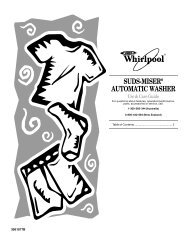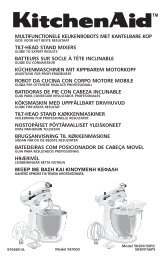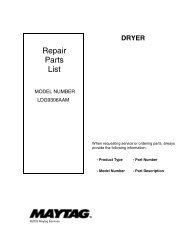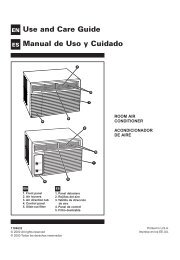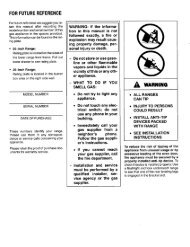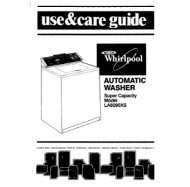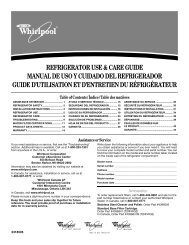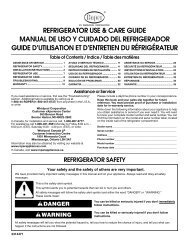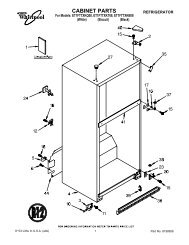electronic electric dryer sécheuse électrique électronique
electronic electric dryer sécheuse électrique électronique
electronic electric dryer sécheuse électrique électronique
Create successful ePaper yourself
Turn your PDF publications into a flip-book with our unique Google optimized e-Paper software.
Cleaning the Dryer Location<br />
Keep <strong>dryer</strong> area clear and free from items that would obstruct the<br />
flow of combustion and ventilation air.<br />
16<br />
Explosion Hazard<br />
Keep flammable materials and vapors, such as<br />
gasoline, away from <strong>dryer</strong>.<br />
Place <strong>dryer</strong> at least 18 inches (46 cm) above the<br />
floor for a garage installation.<br />
Failure to do so can result in death, explosion,<br />
or fire.<br />
Cleaning the Lint Screen<br />
Every load cleaning<br />
The lint screen is located in the door opening of the <strong>dryer</strong>. Clean it<br />
before or after each load. A screen blocked by lint can increase<br />
drying time.<br />
To clean<br />
1. Pull the lint screen straight up. Roll lint off the screen with<br />
your fingers. Do not rinse or wash screen to remove lint. Wet<br />
lint is hard to remove.<br />
2. Push the lint screen firmly back into place.<br />
IMPORTANT:<br />
■ Do not run the <strong>dryer</strong> with the lint screen loose, damaged,<br />
blocked, or missing. Doing so can cause overheating and<br />
damage to both the <strong>dryer</strong> and fabrics.<br />
■ Some towels made of synthetic fibers and natural fibers<br />
(polyester and cotton blends) may shed more lint than other<br />
towels, causing your <strong>dryer</strong>’s lint screen to fill up faster. Be<br />
sure to remove lint from the lint screen before and after drying<br />
new towels.<br />
■ If lint falls off the screen into the <strong>dryer</strong> during removal, check<br />
the exhaust hood and remove the lint. See “Venting<br />
Requirements.”<br />
DRYER CARE<br />
As needed cleaning<br />
Laundry detergent and fabric softener residue can build up on the<br />
lint screen. This buildup can cause longer drying times for your<br />
clothes, or cause the <strong>dryer</strong> to stop before your load is completely<br />
dry. The screen is probably clogged if lint falls off while the screen<br />
is in the <strong>dryer</strong>.<br />
Clean the lint screen with a nylon brush every 6 months, or more<br />
frequently, if it becomes clogged due to a residue buildup.<br />
To wash<br />
1. Roll lint off the screen with your fingers.<br />
2. Wet both sides of lint screen with hot water.<br />
3. Wet a nylon brush with hot water and liquid detergent. Scrub<br />
lint screen with the brush to remove residue buildup.<br />
4. Rinse screen with hot water.<br />
5. Thoroughly dry lint screen with a clean towel. Replace screen<br />
in <strong>dryer</strong>.<br />
Cleaning the Dryer Interior<br />
To clean <strong>dryer</strong> drum<br />
1. Make a paste with powdered laundry detergent and very<br />
warm water.<br />
2. Apply paste to a soft cloth.<br />
OR<br />
Apply a liquid, nonflammable household cleaner to the<br />
stained area and rub with a soft cloth until all excess dye and<br />
stains are removed.<br />
3. Wipe drum thoroughly with a damp cloth.<br />
4. Tumble a load of clean cloths or towels to dry drum.<br />
NOTE: Garments which contain unstable dyes, such as denim<br />
blue jeans or brightly colored cotton items, may discolor the<br />
<strong>dryer</strong> interior. These stains are not harmful to your <strong>dryer</strong> and will<br />
not stain future loads of clothes. Dry unstable dye items inside<br />
out to prevent dye transfer.<br />
Removing Accumulated Lint<br />
From Inside the Dryer Cabinet<br />
Lint should be removed every 2 years or more often, depending<br />
on <strong>dryer</strong> usage. Cleaning should be done by a qualified person.<br />
From the Exhaust Vent<br />
Lint should be removed every 2 years, or more often, depending<br />
on <strong>dryer</strong> usage.



